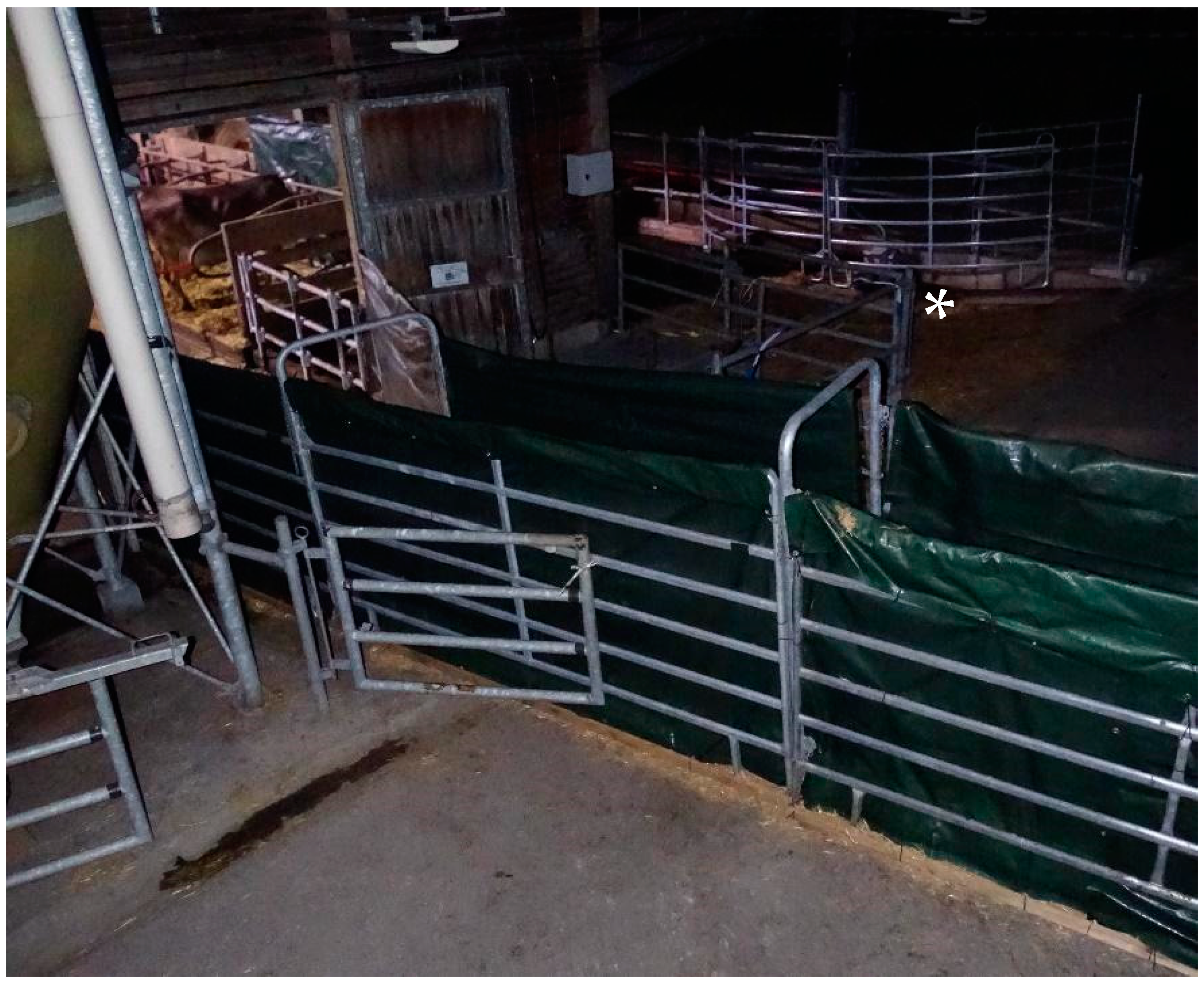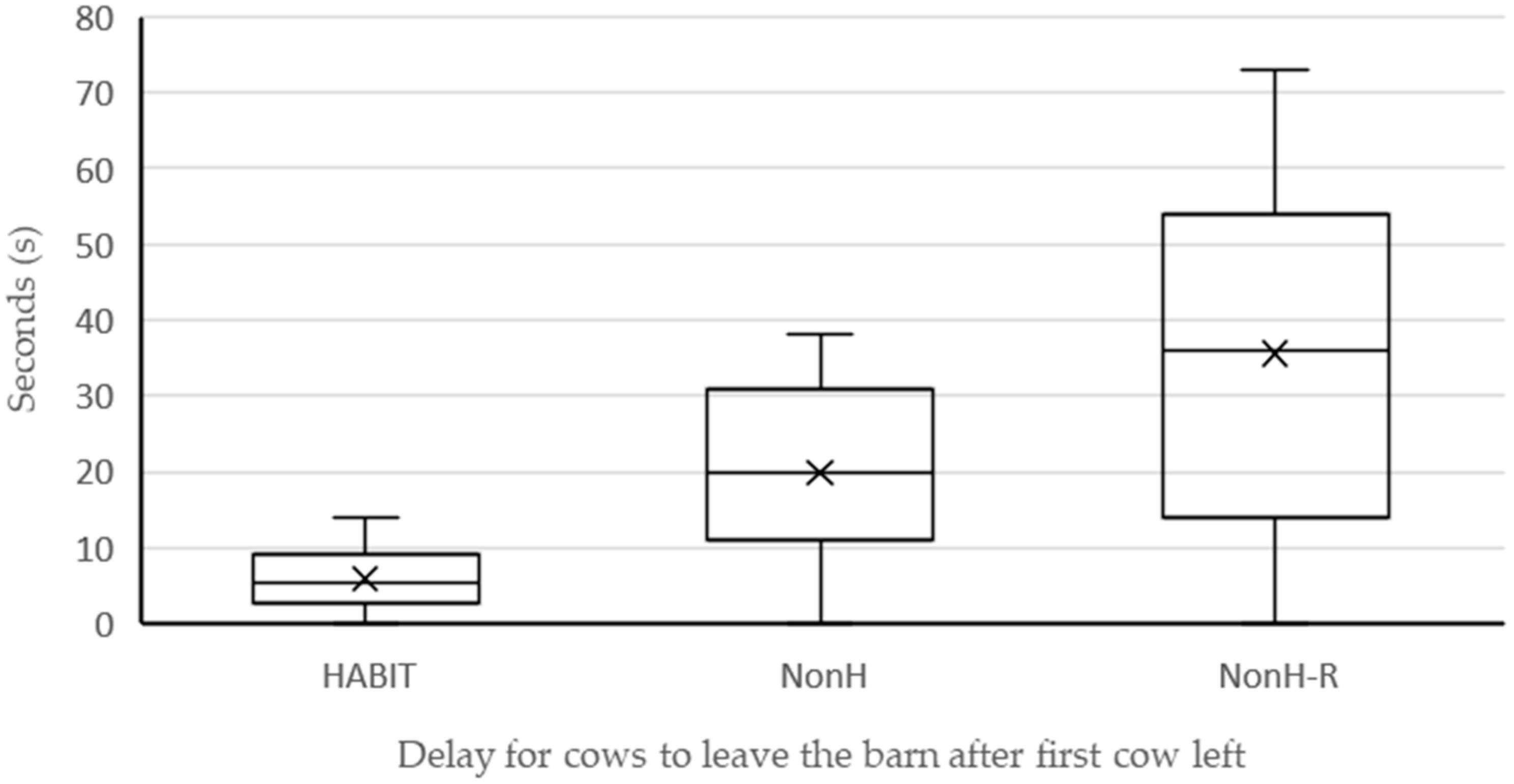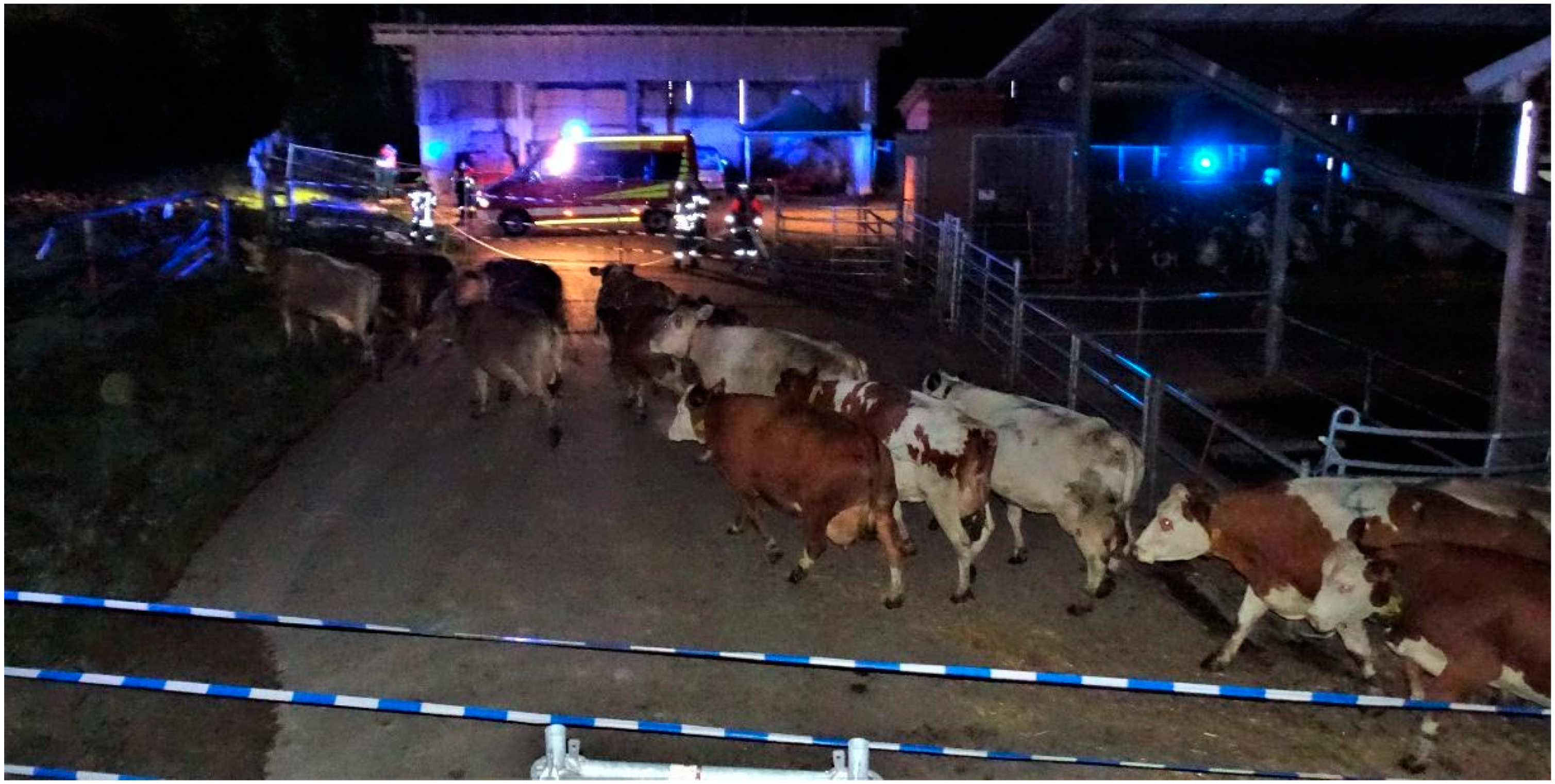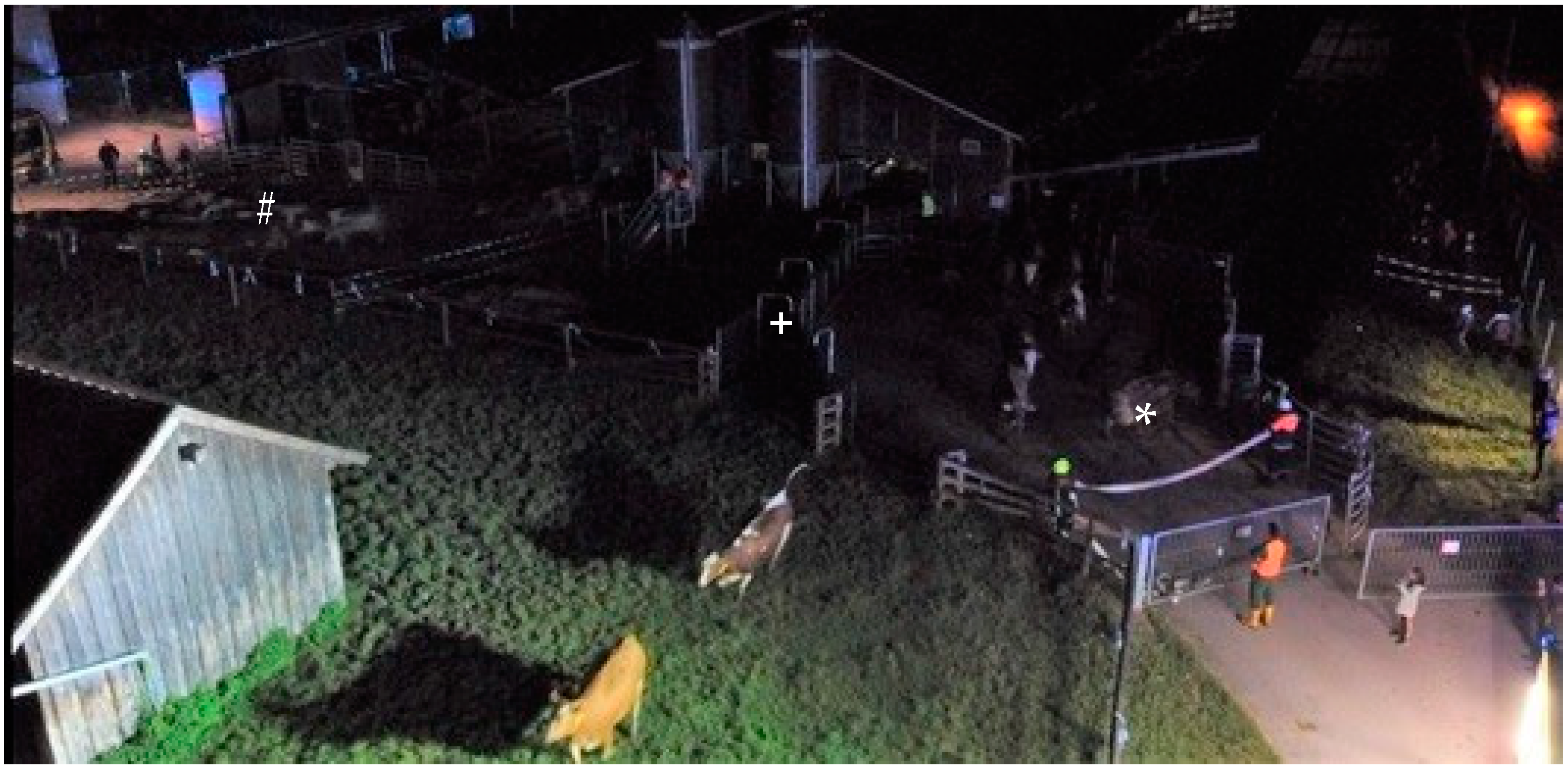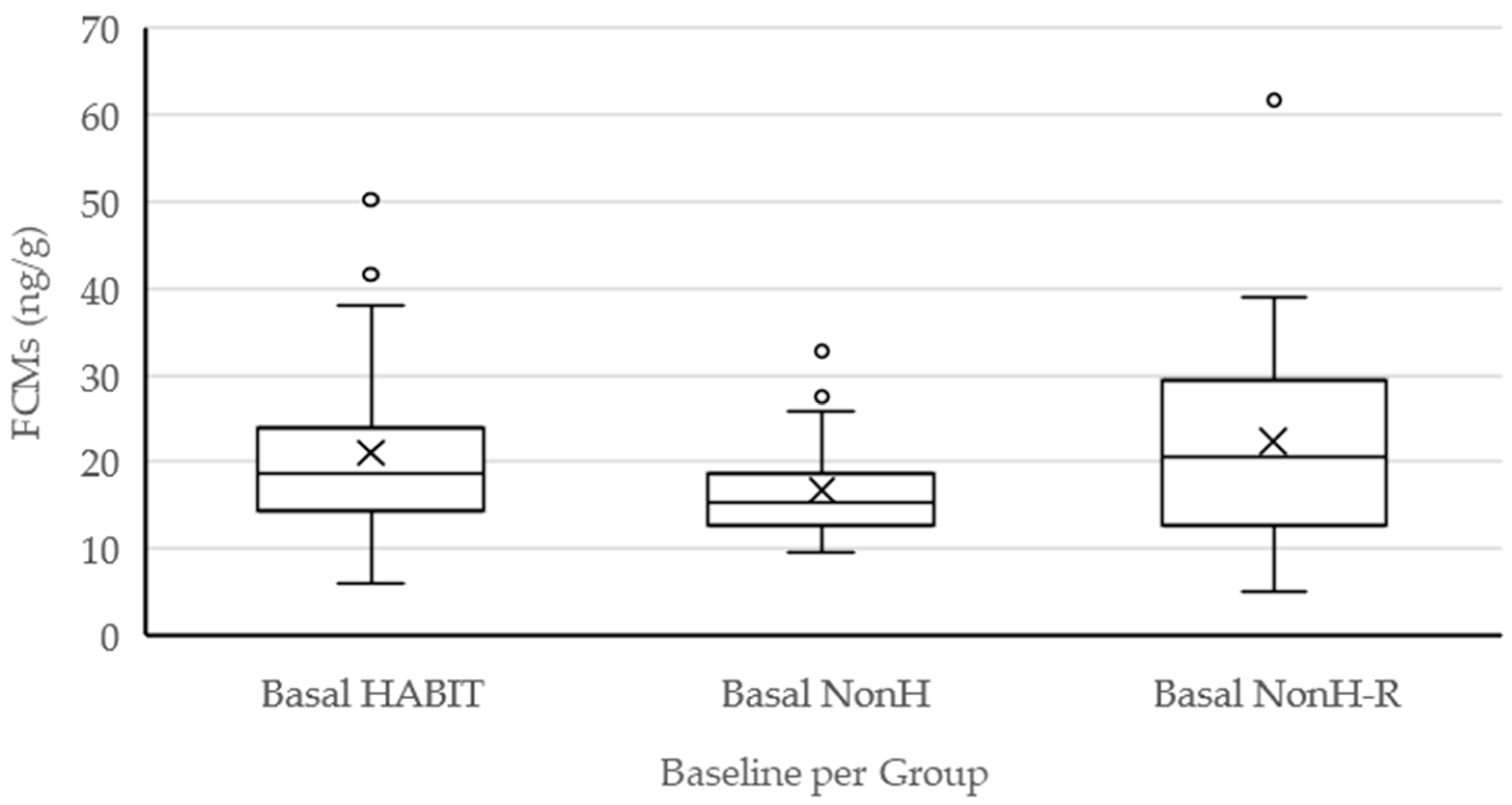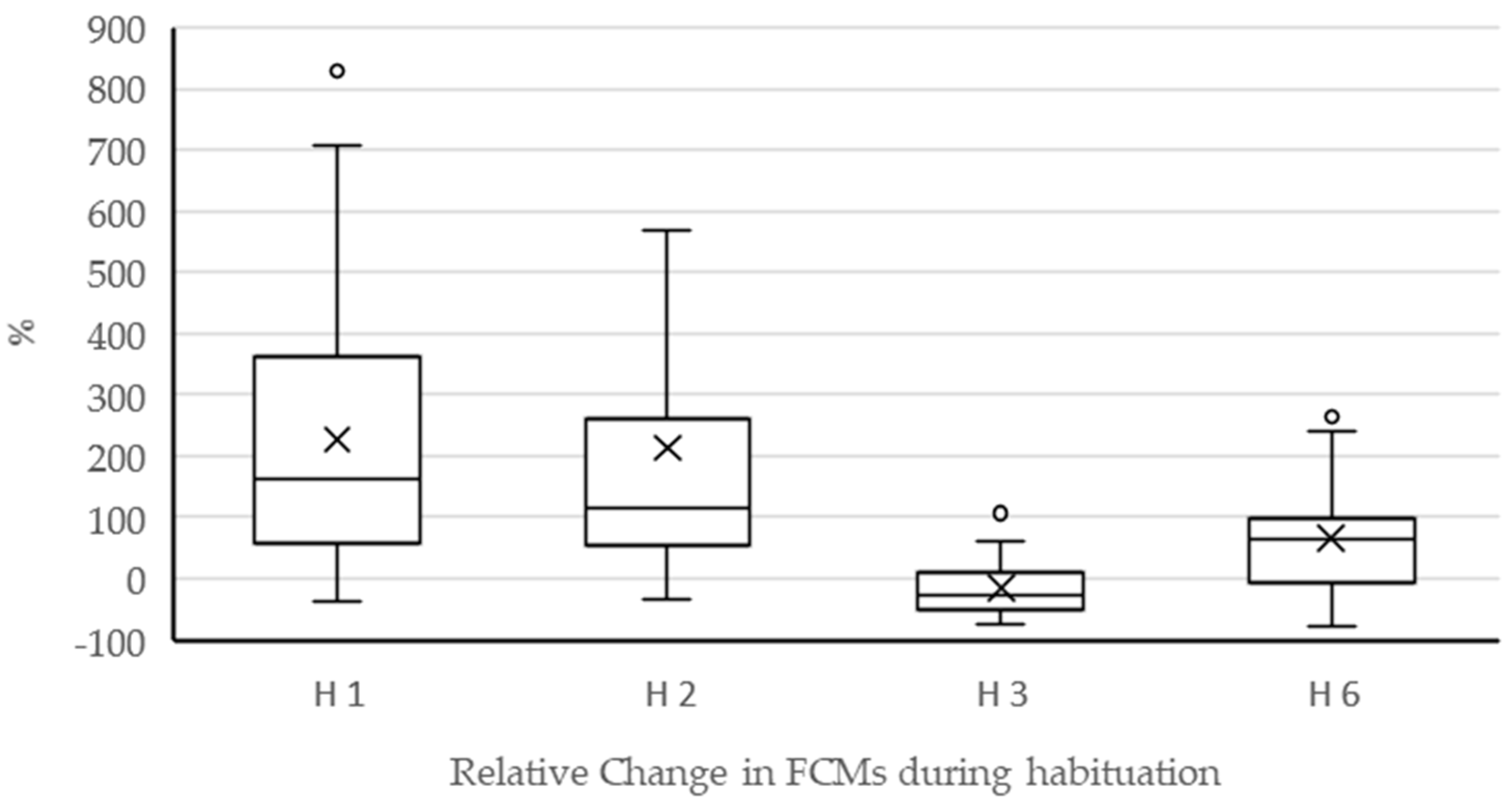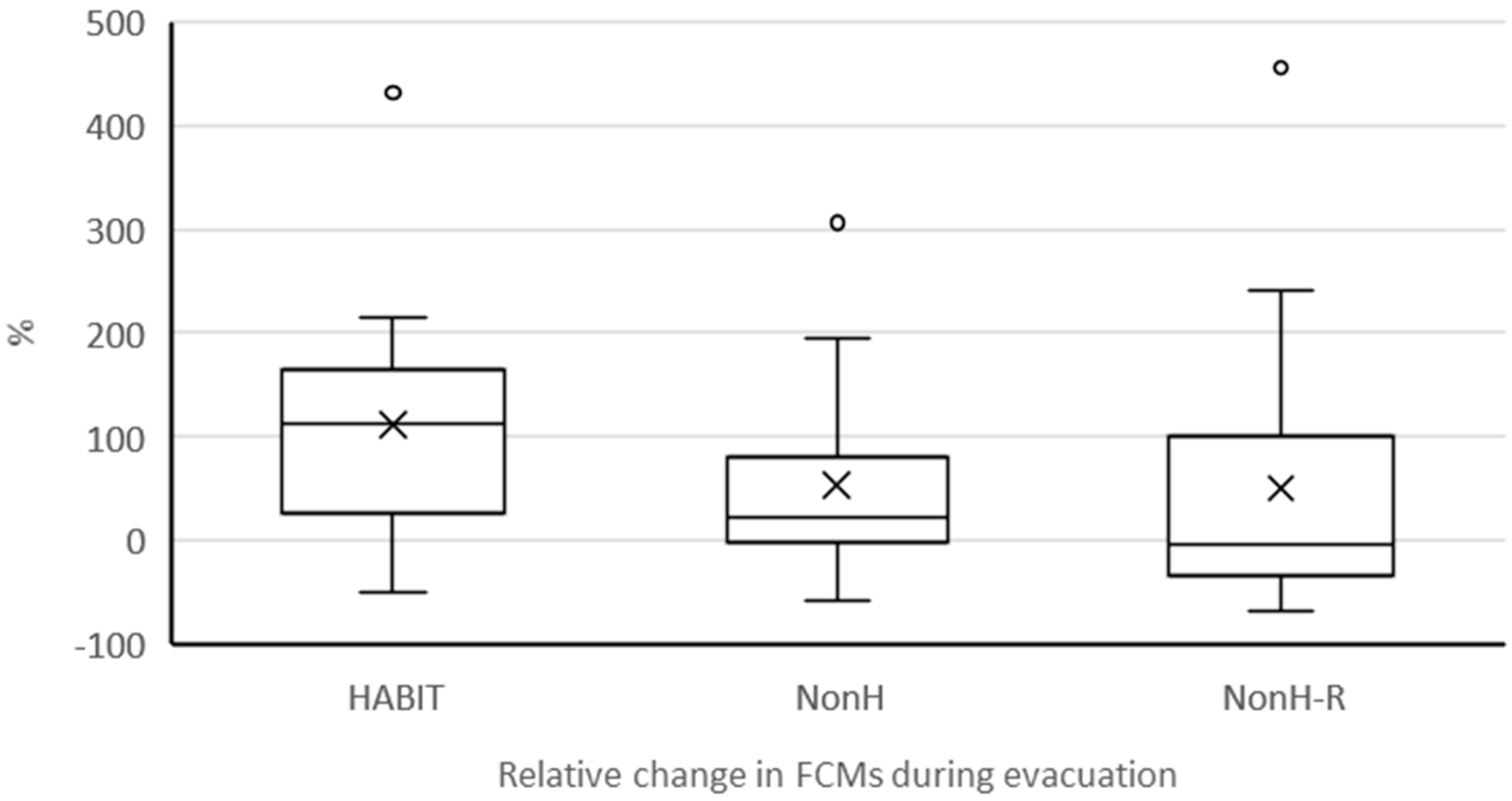1. Introduction
The research problem, concerning the evacuation of cattle in case of a barn fire, is an apparent gap in the current state of knowledge. Statistics about the occurrence of barn fires are scarce. While some data are collected about disasters by public authorities, the focus is usually on human fatalities or economic damages expressed by the value lost [
1,
2,
3]. Concerning barn fires, the data collected vary vastly between countries, forming a patchwork of less expressive statistics. The number of fires in the agricultural sector in Austria is second in ranking right after residential fires [
4]. In The Netherlands, between 0.2% and 0.3% of cattle farms, 0.5% of pig farms, and up to 1.28% of poultry farms are affected by barn fires per year [
5]. In Belgium, around 4% of all fires were barn fires [
6]. In Germany, the umbrella association of insurance companies counts about 5000 barn fires per year, being around 2.5% of all fires recorded, while there is no further differentiation between species and the number of affected animals [
7].
There are many media reports concerning barn fires that are reviewed by animal welfare organisations [
8,
9], which in turn demand revised construction codes for barns, such as obligatory sprinkler systems or fire detection systems. While guidelines exist for the prevention of barn fires [
10], there are no instructions on how to best evacuate livestock or how to design exits. The World Organisation for Animal Health (OIE) only mentions the general need for evacuation plans in their Terrestrial Animal Health Code [
11] (Article 7.11.17 No. 16). Further recommendations limit themselves to specifying the minimum width of exits to be 1.5–2 times the largest animal width or elucidating the amount of exits and the maximum travel distance to an exit, with no further instructions given [
12,
13].
Farmers who are at risk of suffering from bush fires are given information about the logistics of transporting groups of animals through the countryside [
14,
15], triage references for assessing cattle after a fire (i.e., when fences trap the animals) [
16], and feeding them afterwards [
17]. However, the animals’ reaction towards wildfires cannot be considered illustrative concerning the situation in a constricted space such as a barn, since the animals in an open field have plenty of options to evade the fire or even take advantage of it in hunting or foraging [
18,
19].
Regarding the behaviour of farm animals during a barn fire, there are only empirical field reports from affected farmers and firefighters. Factsheets underline the variety of animal behaviours, ranging from panic to aggression [
20,
21]. In addition, stoicism following exposure to smoke can result from early stages of carbon monoxide poisoning [
22]. With respect to horses, guidance on blindfolding the animals and leading them out of the barn individually highlights the problematic instinct of the animals to seek refuge in their familiar housing [
23]. The same instinct should be expected in other farm animals, but to a lesser extent if the animals are used to pasture [
24,
25]. In general, the willingness to accept an exit is improved by the habituation of the animals to it. Evacuation routines for livestock were proposed to become obligatory in East Germany [
26]. In the 1980s, experimental evacuations of livestock took place in Russia [
27]. Ruppert cites these studies in his dissertation, describing the observations that cattle habituated to pasture left the barn on their own, but only through the known openings. In contrast, non-habituated cattle took greater effort in terms of time and manpower [
24] (pp. 56–58).
These field reports are congruent with prevailing opinions about herding and handling cattle, based on their physiology, ethology, and sensory perception. There are similarities between how to evacuate cattle in the case of a fire and how to reduce stress within cattle at the slaughter plant. In both cases, it is necessary to herd stressed cattle to an unknown location. Thus, the extensive work of Temple Grandin about welfare audits and handling and herding groups of cattle must be considered. Cattle choose an unpleasant but known option rather than one unknown to them [
28]. Considering the sight of cattle, the adaptation to light is up to five times slower than in humans [
29]. A path orderly lighted by the fire brigade at night or bright sunshine in the daytime might be glaring and blinding for cattle. In addition, the depth perception of cattle is worse than of humans, resulting in the need for cows to inspect sharp contrasts on the floor, such as those created by shadows [
30]. Because of this, the movement of a group of cows might be hindered or even stopped. In order for cows to accept races, for example, at the slaughter plant, they need safe footing and a clear line of sight [
31]. The same is true for unknown flooring. In general, every distraction such as deflections, unknown vehicles, or persons around the exit can result in cattle balking, refusing to move, or turning around [
32]. This knowledge should also be applicable to evacuating in case of a barn fire.
To evaluate the success of an evacuation, the primary concern is the required time. Secondarily, the assessment of stress in the cattle can be an indicator of the willingness to use the escape route. However, the direct method of assessing stress by collecting blood samples right after evacuation and quantifying the serum cortisol level would not be possible, as catching and immobilising the animals on pasture for blood sampling risks additional superimposing stress [
33]. Instead, quantifying faecal cortisol metabolites (FCMs) is a well-established, non-invasive approach in objectively comparing stress responses in animals [
34,
35,
36,
37]. Furthermore, due to the delay of faecal excretion, sampling faeces for quantifying FCMs must take place several hours (cattle: ~9–12 h) after the stressful event, as summarised by Palme [
38].
In an effort to reduce the number of farm animals perishing in barn fires, this pilot study was undertaken. The practical goal of the study was to explore possible designs of egress and strategies evacuating cattle. The supporting, more scientific goal is to explore stress responses in cattle during evacuation. Our approach was to simultaneously evacuate three separated groups of cattle at night in cooperation with the fire brigade, advancing realistically with sirens and flashing lights, comparing two differently designed exits and the effect of habituating cattle to the exit beforehand. The long-term objective of this research topic is to establish the best practices within barns for emergencies. The aim of this study, therefore, was to indicate promising designs of openings for evacuation by recording behavioural and physiological stress responses of cattle during their rescue, thus encouraging farmers to develop rescue concepts for their farms.
2. Materials and Methods
2.1. Ethical Note
This study was approved by the competent authority of the administration of Upper Bavaria, Germany, with the internal approval code “ROB-55.2-2532. Vet_02-21-40” in compliance with the convened Ethical Committee for the use of experimental animals according to § 15 Animal Protection Law, Germany.
2.2. Animals and Housing
Since to the authors’ best knowledge, no comparable study exists, it was difficult to predict the behaviour of the animals used in this study during evacuation. Thus, we needed to choose the amount of stressors carefully, in accordance with the principle of refinement. For this pilot study, we focused on dairy cattle because of the advantageous conditions for rescue with this kind of husbandry. Dairy cattle are used to being handled, the housing is less subdivided, and the animal density in the stable is lower than in beef cattle or with other livestock.
The study was carried out in September 2021 at the educational and research farm Achselschwang in Bavaria, Germany. After weaning, the young cattle were raised at another site, having partial access to pasture. Right before calving, they returned to the main farm and were included in the lactating herd postpartum. They were housed year-round, with no access to pasture, in a sideways open freestall barn with deep-bedded cubicles and rubber matted flooring in the cubicle alleys. Animals were fed a total mixed ration with grass and corn silage, with additional concentrate feeding individually at feeding stations. Milking took place twice a day in a double eight-herringbone parlour.
In preparation for evacuation, one group of cows was habituated to using an exit out of the barn and up to a pasture (HABIT, n = 23). This was possible without repeatedly selecting them from all lactating cows, because they formed the low-performance group on the farm. Two other groups of cows were not habituated to leaving the barn. Between them, the means of egress differed, with one group exiting through a single-file race (NonH-R, n = 23) and the other group exiting through a wider opening (NonH, n = 23). Cows were assigned randomly to NonH and NonH-R shortly prior to evacuation.
Breeds in HABIT, NonH, and NonH-R were mixed with mostly Simmental (S) or Brown Swiss (B) and a few Red Holstein (RH) or hybrids with beef cattle (beef) (S-B-RH-beef; 11-6-2-4 vs. 11-9-0-3 vs. 8-8-4-3). The average age of the HABIT group differed from NonH and NonH-R (mean ± SD; 4.64 ± 2.89 vs. 5.25 ± 1.65 vs. 5.47 ± 1.23 years), as did parity (2.57 ± 2.70 vs. 3.22 ± 1.56 vs. 3.43 ± 1.06 lactations), daily milk yield (28.05 ± 3.70 vs. 41.28 ± 5.09 vs. 42.01 ± 3.55 kg), and days in milk (181 ± 95 vs. 112 ± 69 vs. 123 ± 69 days). Cows in the last trimester of gestation were not included in this study.
Initially and repeatedly during the habituation period of HABIT, cows’ health status was assessed, with defined study abort criteria. Assessment of cows in NonH-R and NonH took place in the morning of the day of evacuation. All cows were clinically healthy, had no signs of lameness, and had a BCS between 2.5 and 4 (mean ± SD; 3.08 ± 0.36 vs. 3.07 ± 0.26 vs. 2.92 ± 0.32). On the day after evacuation, lameness and general condition were assessed again, with only one cow having a contusion at an udder quarter, which was treated locally.
2.3. Design of Egress
The area in front of the barn was an asphalt surface of 20 m width, adjacent to around 0.8 hectares of corralled pasture. Blue and white striped barrier tape was fixed in short distances to the pasture fence for improved visibility. Cows in HABIT went on pasture after milking in the morning for eight days prior to evacuation, using the same means of egress. They remained on pasture for 45 to 60 min before returning to the barn.
For evacuation, each group had its own escape route. HABIT and NonH-R were positioned in 2.5 m wide cubicle alleys, while NonH was positioned in the 4 m wide feed passage. Crossover passages between the cubicle alleys were closed off. Between cubicles of HABIT, NonH, and NonH-R, screening walls were put up to prevent reciprocal influences between the groups. At the end of the cubicle alleys, openings in the wall of the barn were closed off by swinging gates of 2.6 m width, while a 2.8 m swinging gate closed off the feed passage. Since all gates swung only inwards, they had to be opened before the start of evacuation to prevent trapping cows. The openings were barred by lashing straps.
The single-file race for use of NonH-R was formed out of interlocking panels (Panel-6; 1.7 m height; Patura, Laudenbach, Germany), covered with opaque weatherproofing tarpaulin, which was fixed tightly to the metal of the panels to prevent rustling (
Figure 1). The race narrowed from 2.6 m width at the barn opening to a single-file race of 0.9 m width in 2.5 m distance to the opening and ran straight to the corralled pasture, thus screening cows of NonH-R from visual distractions. It separated the exits of NonH and HABIT and prevented visual contact between the groups outside of the barn.
Behind each opening, there was a grid for dropping manure collected by automatic scrapers. Unprepared, those openings would be unsuitable for evacuating cattle, since the grid structure was wide enough for cow claws to slip through. Thus, the grids were covered by wooden boards with struts gripping the grid structure. The same rubber mats as those used as flooring in the cubicle alleys were tacked to the wooden boards to provide cows with familiar flooring at the opening and to prevent slipping.
The setup took place in the afternoon before evacuation. The fire brigade arrived at 8:00 p.m., one hour after sunset, with milking ending at around 5:00 p.m. They advanced with sirens, blue lights, and full gear, parking their vehicles realistically close to both sides of the barn. Sirens were shut down upon arrival, but blue lights were kept going until all cows were on pasture.
Although power cuts are common in barn fires, the low lighting inside the barn was not turned off to respect the safety of the herding personnel and to allow video footage of the evacuation. Outside, the fire brigade put up spotlights to illuminate the area in front of the barn as well as the pasture to which the cows were to be evacuated. The spotlights were positioned orthogonally to the escape routes in order to avoid blinding the animals.
Each group of cows was herded by one employee of the farm, known to the animals, and one firefighter, unknown to the animals. They herded the animals by moving towards them, waving arms and calling out but without touching the animals, as instructed, after additional farm personnel opened the lashing straps and moved aside.
Cows of all three groups were mixed and left on pasture for about 30 min before farm personnel herded them back to the barn and separating them again.
2.4. Measures and Data Collection
To evaluate the success of evacuation, we focused on the required time for cattle to leave the barn. However, assessment of stress reactions in the cows was of interest as well, since highly stressed cattle would be more likely to seek refuge in familiar surroundings and to resist being herded outside. Furthermore, panicking animals present a danger especially to bystanders or untrained handlers, including the fire brigade.
The time needed for evacuation was analysed by recording video footage. In use was a Dual-Sensor Camera (AXIS P3715-PLVE Network Camera; Axis Communications GmbH, Ismaning, Germany), which was fixed to the ceiling of the barn, aiming the lenses to both sides, capturing all three exits. In addition, camcorders were set up outside the barn. Two drones (DJI Mini 2; Da-Jiang Innovations Science and Technology CO, Shenzhen, Guangdong) were also in use, capturing the area outside the barn and the behaviour of cows on pasture. In the same manner, the habituation of HABIT to pasture prior to evacuation was recorded.
For evaluating physiological stress reactions in the cows, faecal samples were collected and FCMs were quantified. Sampling took place with cows in headlocks at the feeding fence after milking, 10 h ± 15 min after evacuation. In the same way, faecal samples of HABIT were taken at days 1, 2, 3, and 6 of habituation. Faecal samples of each cow were taken beforehand to determine their baseline FCM levels. Sampling for baseline took place in the morning after milking, when FCM concentration should reflect the serum cortisol levels of the cows while resting, 9 to 12 h beforehand. Cows of HABIT were sampled on the day before habituation, while cows of NonH and NonH-R were sampled in the morning of the day of evacuation. Faeces were taken manually from the rectum or directly during the process of defecating, but never from the ground, using disposable rectal examination gloves and filling faeces into sample tubes (Sample Container 70 × 24 mm, 17 mL Volume; Süsse, Gudensberg, Germany). During sampling, the behaviour of the animals was checked for unease using a Score Sheet with defined abort criteria. Samples were preserved at −20 °C in a deep freezer at the farm, directly after collecting and labelling them. They were then transported in a mobile freezer at −18 °C to the laboratory of the Chair of Animal Welfare, Ethology, Animal Hygiene and Animal Husbandry, Department of Veterinary Sciences, Faculty of Veterinary Medicine, LMU Munich, for extraction by dispensing 0.5 g faeces in 5 mL of 80% methanol and draining the supernatant after vortexing for 30 min and centrifuging at 2500×
g for 15 min [
33,
39,
40]. FCMs were then quantified using an 11-oxoaetiocholanolone enzyme immunoassay (EIA measuring 11,17-dioxoandrostanes). Details of the EIA are described elsewhere [
41,
42]. FCM concentrations are expressed in nanograms per gram of fresh faeces. The sensitivity of the EIA is 2.2 ng/g. Intra-assay and inter-assay coefficients of variations were below 10% and 12%, respectively.
The milk yield of cows in all groups was recorded twice a day in the parlour using flow meters. The combined milk yield in litres was corrected in accordance with German animal products law with the factor 1.03 to state the milk yield in kilograms.
2.5. Statistical Analysis
Statistical analysis was performed using IBM SPSS Statistics Version 26 and the open software R. Boxplots were produced for the data on the required time for evacuation, the milk yield, and the FCMs of the three different groups, stratifying for lactation if necessary. Data on milk yield and FCM were assessed visually for normality using these boxplots and Q-Q-Plots. As most data were not normally distributed, all analyses were conducted using non-parametric statistical tests. Data were analysed for differences between the three groups, using the Kruskal–Wallis test with subsequent Mann–Whitney U-tests for pairwise comparison using the Bonferroni correction. Baseline FCM concentrations were compared to the concentrations after evacuation using a paired Wilcoxon test. Relative differences (in %) in the FCM concentrations were compared using Kruskal–Wallis-tests. Differences in milk yield prior to evacuation (mean of 14 days prior to evacuation) and the individual milk yields in the seven days post-evacuation were analysed using Friedman’s test, a non-parametric test for paired data. The difference (in litres) between the mean daily milk yield of the three days post-evacuation and the 14 days prior to evacuation were compared between the three groups using Kruskal–Wallis tests with subsequent Mann–Whitney U-tests for pairwise comparison using the Bonferroni correction. The relationships between the change in FCM concentration and the change in milk yield before and after evacuation were analysed using Pearson correlation. All p-values less than 0.05 were considered statistically significant.
4. Discussion
The results of this first explorative study, concerning the evacuation of cattle, indicate the effectiveness of exits, which are adjusted to the sensory physiology of the animals, to respect animal welfare and to prevent losses caused by fire or natural disaster.
The range of FCM values differed strongly between individual animals, as was also shown in the literature [
41,
43]. With median baseline of all cows at 17.4 ng/g, our results fit the findings of previous studies, falling, for example, in between the results of Rouha-Mülleder et al. with median baseline of 23.4 ng/g [
43] and of Ebinghaus et al. with 11.0 ng/g [
36].
Since analytical methods as well as sampling, storing, and transport influence the results of FCM quantification, a direct comparison of values between different studies might not be informative. In addition, the influence of health status as well as milk yield on the FCM concentration is not yet fully explored. Rouha-Mülleder et al. found a correlation between decubitus at tarsal joints and higher FCM concentrations [
43]. Ivemeyer et al. found a correlation between lower baseline FCM values and the rate of self-curing udder disorders, defined by staying below 100,000 somatic cell count over three months following a somatic cell count of over 200,000 [
44]. Bertulat et al. found differences in baseline FCM concentrations among low-, medium-, and high-yielding groups of cows, with lower values for the latter [
45]. On the other hand, Pesenhofer et al. found no differences in FCM concentration between cows without lameness and cows with scores indicating slight or marked lameness [
35]. To account for such individual differences, it has been suggested that each animal acts as its own control [
38,
40]. Therefore, the individual FCM rise (in relation to its baseline) following the stressful event was used to assess the physiological reaction of each cow to the event.
Sampling once after a stressful event, FCM values can depict the general level of stress the animals were affected with over a stretch of time by interpretation of the rise in concentrations, but without reliably depicting the peak, which would require repeated sampling. Pesenhofer et al. measured the peak of FCM concentration 9 h after a stressful event [
35]. Heinrich et al. noted a plateau in FCM concentration after 9 h, rising only slightly until 11 h after the occurring stress [
37]. Palme et al. described that a peak in FCM followed a peak in plasma cortisol concentration 10 h later [
41], while Möstl et al. found that a peak in FCMs in cattle occurred 12 h after transportation [
34]. To achieve the main objective of this study, the comparison of evacuation behaviour between cows in HABIT, NonH, and NonH-R, it was not mandatory to pinpoint safely the peak of FCM rise after evacuation, but to compare the rise in FCMs after the same amount of time between the groups. Repeated measurements might have revealed more details in FCM excretion.
For cows in HABIT, being younger on average than cows in NonH and NonH-R, less time passed on average since they were on pasture at the farm site where all cows were kept as young cattle. This should not have had an interfering effect on the rise in FCMs after evacuation, for there was no significant difference between uniparous and multiparous cows. However, cows in HABIT being younger could have influenced the quickness of habituation. The return to baseline values in FCM concentrations already on day three of the habituation period implies a swift and successful familiarisation of cows in HABIT.
The rise in FCM levels after evacuation in this study was comparably moderate. It was less than the rise in FCMs during heat stress exposure, as reported by Veissier et al. [
46]. For HABIT, the rise in FCMs was comparable to the change in FCMs that Kuhlberg et al. noticed in heifers between one week prepartum and two weeks postpartum [
47]. Our results indicate cows sufficiently accepting the designed openings, allowing for swift rescue. This is contrary to our expectations, resulting from field reports of firefighters and affected farmers, emphasising the difficulty in moving unhabituated cows out of the barn. One influencing factor may be that cows on the educational and research farm were more used to foreign persons and procedures than cows on commercial dairy farms.
In conclusion, possible differences in the amount of stress experienced in the moments of leaving the barn, resulting from the different designs of evacuation between the groups, were not high enough to significantly affect the whole level of stress on the evening of evacuation. More likely, the FCM concentrations of the samples taken the following morning depicted imposing stress by mixing groups on pasture and by herding cows back to the barn, as well. While highlighting intriguing directions of future research, this study can neither differentiate nor quantify the influences of the factors investigated.
Reactions in the hypothalamic–pituitary–adrenal axis to a stressful event can be evaluated by FCMs. Additionally, reactions in the sympathoadrenal axis of the autonomic nervous system, regulating variations in the heart rate, can be depicted to assess stress. Concerning follow-up studies, the option of using sensors recording intervals between two following R-waves (RR-Intervals) to register the heart rate variability (HRV) at various defined points of time during evacuation should be considered to improve differentiation [
48].
Surprisingly, the reduction in milk yield after evacuation was only statistically significant in HABIT and was not dependent on the lactation number of the cows. Additional stress caused by the sudden halt of access to pasture in the morning might have influenced this. Our results concerning milk reduction are comparable with the findings of Pesenhofer et al., describing a decline in the median of daily milk yield by 0.6 L on the day after claw trimming in comparison to the median of the 7 days prior to claw-trimming [
35]. Gräff found a mean reduction of 0.55 L 10 days past a simulated power cut of an automatic milking system in comparison to the 10 days prior [
49]. However, Broucek et al. noticed a reduction of 23.3% in daily milk yield on the first day after transferring a herd of Holstein cows from stanchion-stall housing to a new facility with freestall housing [
50].
Concerning the design of the openings, the access to cubicles seemed to have an impact on the response time between opening the lashing straps and the first cow leaving the barn. For NonH, this was only 6 s, being herded through an opening at the end of the feed passage, without access to cubicles. For NonH-R, this was 87 s, with cows firstly evading the pressure built by the herding personnel by retreating in cubicles instead of choosing the opening through the race upon pasture. For HABIT, despite having access to cubicles, it took only 22 s until the first cow left the barn. This response time, besides differences in access to cubicles, might have also been influenced by hard-to-standardise herding pressure of the firefighters and the farm personnel, as well as random positioning of cows in front of the exit at the moment of opening the lashing straps.
After the first cow of NonH-R went into the race, the other cows followed in a mostly steady line. Since it was a single-file race, the interval between individual cows leaving the barn was considerably longer than with NonH or HABIT, for which the openings were wide enough for two cows to fit through simultaneously. The swiftness of cows in NonH to leave the barn might have been influenced by being herded in the broader feed passage in addition to having an opening that was slightly wider than openings for NonH-R and HABIT. However, the delay between the first and last cow leaving the barn was still significantly longer with NonH than for HABIT.
Neither the hypothetical advantage of the race blocking the sight of cows to the vehicles, personnel, lights, and other potential stress inducing distractions, nor the potential advantage of the race to prevent cows from turning around and retreating back into the familiar barn have proven to be effective or rather necessary with the presented experimental setting. Although a few cows in NonH turned around, trying to get back into the barn and escape the unknown impressions outside, the herding personnel were able to dissuade them easily. This was certainly supported by the positive effect of the design of the escape routes, which were adapted to fit the sensory physiology of cattle, with focus on lighting and surface, following the guidelines of the extensive work of Temple Grandin [
30,
31,
32]. We were surprised nonetheless by the apparent effectiveness of these slight adaptations. While the positioning of the lights at night by the fire brigade is adaptable, bright sunshine in the daytime is not, and can be glaring for cattle, as well. If possible, an evacuation route with a shaded opening, averting the sun, should be considered.
With cows in HABIT, turning around outside the barn was not observed. They seemingly were able to transfer their habituation of the route to pasture, which they previously learned was safe in calm circumstances, to a stressful evacuation with the fire brigade present. They left the barn readily in bulk, with the lowest time needed between the first and last cow leaving the barn. Outside, they seemed rather relaxed, with some cows watching the fire brigade while standing on the concrete area between barn and pasture. They were not trying to get back to the barn and were more laid-back reacting to the pressure of the herding personnel than cows in NonH. This observed calmness was not depicted by a significant difference in FCMs between HABIT and NonH or NonH-R. An evacuation late at night might have been more conclusive, with cows being even more inactive in the middle of the resting period instead of right after sunset.
Because, to our knowledge, there are no comparable studies to predict animal behaviour, it was necessary to start the experimental design with a low array of stressors. This was carried out in accordance with the rule of refinement, formulated by Russel and Burch in 1959 [
51], and consequential to being mindful of experimental safety, especially towards the herding participants of the fire brigade with less experience concerning animal behaviour. However, the moderate change in FCM levels in all groups compared to baseline implies that a more realistic experimental design might be necessary and ethically acceptable. To highlight further effects of different designs of openings on the success of evacuation, additional stressors might be needed, simulating a more realistic emergency scenario and ensuring the applicability of the results. Subsequent studies should explore, for example, the usage of hot smoking installations inside the barn or locally controlled fires, improving the realism of the study design concerning sight, smell, and temperature.
